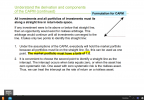navjyotbirdy
New Member
Hey guys,
Though I might sound stupid, but can you please put in more light to the statement that market portfolio must have a beta of 1. Though I understand that any individual investor as per CAPM will have identical portfolios but there respective portfolio will vary as per their risk preferences due to which the quantity of Beta can vary across all individual investor.
Here's a screenshot for reference:

Regards,
Navjyot
Though I might sound stupid, but can you please put in more light to the statement that market portfolio must have a beta of 1. Though I understand that any individual investor as per CAPM will have identical portfolios but there respective portfolio will vary as per their risk preferences due to which the quantity of Beta can vary across all individual investor.
Here's a screenshot for reference:

Regards,
Navjyot

